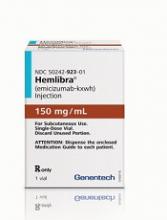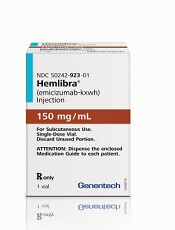User login
Results of a phase 3 trial showed that prophylaxis with emicizumab significantly reduced bleeds, compared to no prophylaxis, in patients with hemophilia A without inhibitors.
Emicizumab also reduced bleeds when compared to prior factor VIII prophylaxis.
The most common adverse events (AEs) in this trial were injection site reactions, arthralgia, nasopharyngitis, headache, upper respiratory tract infection, and influenza.
Johnny Mahlangu, MBBCh, of the University of the Witwatersrand and NHLS in Johannesburg, South Africa, and his colleagues reported these results, from the HAVEN 3 trial, in NEJM.
The trial was sponsored by F. Hoffmann–La Roche and Chugai Pharmaceutical.
“In the HAVEN 3 study, [emicizumab] showed a significant and clinically meaningful reduction in bleeds in people with hemophilia A without factor VIII inhibitors, while offering multiple subcutaneous dosing options,” Dr. Mahlangu said.
“The publication of these results . . . represents a major advance for hemophilia research and reinforces the potential of [emicizumab] to change the standard of care for people with hemophilia A.”
HAVEN 3 included 152 patients with hemophilia A (age 12 and older) who were previously treated with factor VIII therapy either on-demand or for prophylaxis.
Patients previously treated with on-demand factor VIII were randomized in a 2:2:1 fashion to receive:
- Emicizumab prophylaxis at 3 mg/kg/wk for 4 weeks, followed by 1.5 mg/kg/wk for at least 24 weeks (arm A)
- Emicizumab prophylaxis at 3 mg/kg/wk for 4 weeks, followed by 3 mg/kg/2wks for at least 24 weeks (arm B)
- No prophylaxis for at least 24 weeks (arm C).
Patients previously treated with factor VIII prophylaxis received emicizumab prophylaxis at 3 mg/kg/wk for 4 weeks, followed by 1.5 mg/kg/wk until the end of study (arm D).
Episodic treatment of breakthrough bleeds with factor VIII therapy was allowed per protocol.
Efficacy
Emicizumab reduced treated bleeds by 96% (rate ratio [RR]=0.04; P<0.0001) when given every week and 97% (RR=0.03; P<0.001) when given every 2 weeks, compared to no prophylaxis. The annualized bleeding rate (ABR) was 1.5, 1.3, and 38.2, respectively.
Emicizumab reduced all bleeds by 95% (RR=0.05; P<0.001) when given every week and 94% (RR=0.06; P<0.001) when given every 2 weeks, compared to no prophylaxis. The ABR was 2.5, 2.6, and 47.6, respectively.
There were zero treated bleeds in 55.6% of patients who received emicizumab every week and 60% of patients who received emicizumab every 2 weeks, compared to 0% of patients who did not receive prophylaxis.
In an intra-patient comparison of people who previously received factor VIII prophylaxis in a prospective non-interventional study and switched to emicizumab prophylaxis, emicizumab reduced treated bleeds by 68% (RR=0.32; P<0.001).
The ABR was 1.5 when patients were on emicizumab and 4.8 when they were on prior prophylaxis.
Safety
The most common AEs were injection site reactions (25%), upper respiratory tract infection (11%), nasopharyngitis (12%), arthralgia (19%), headache (11%), and influenza (6%).
One patient in group B stopped treatment due to multiple low-grade AEs considered related to emicizumab. The AEs were insomnia (grade 2), alopecia (grade 1), nightmare (grade 2), lethargy (grade 2), pruritus (grade 1), headache (grade 1), and depressed mood (grade 1).
Serious AEs included bleeding events (n=4), cardiac disorder (n=1), infection (n=3), musculoskeletal disorders (n=3), loosening of an orthopedic device (n=1), psychiatric disorder (n=1), and trauma (n=1). One patient experienced nephrolithiasis after a dose increase to 3 mg/kg/wk.
None of the serious AEs were considered related to emicizumab.
There were no deaths, cases of thrombotic microangiopathy, thrombotic events, or new cases of factor VIII inhibitors.
Two patients had detectable inhibitors at baseline, but titers declined spontaneously during the trial. Another patient had a detectable inhibitor titer at week 13 that spontaneously declined at week 25.
Results of a phase 3 trial showed that prophylaxis with emicizumab significantly reduced bleeds, compared to no prophylaxis, in patients with hemophilia A without inhibitors.
Emicizumab also reduced bleeds when compared to prior factor VIII prophylaxis.
The most common adverse events (AEs) in this trial were injection site reactions, arthralgia, nasopharyngitis, headache, upper respiratory tract infection, and influenza.
Johnny Mahlangu, MBBCh, of the University of the Witwatersrand and NHLS in Johannesburg, South Africa, and his colleagues reported these results, from the HAVEN 3 trial, in NEJM.
The trial was sponsored by F. Hoffmann–La Roche and Chugai Pharmaceutical.
“In the HAVEN 3 study, [emicizumab] showed a significant and clinically meaningful reduction in bleeds in people with hemophilia A without factor VIII inhibitors, while offering multiple subcutaneous dosing options,” Dr. Mahlangu said.
“The publication of these results . . . represents a major advance for hemophilia research and reinforces the potential of [emicizumab] to change the standard of care for people with hemophilia A.”
HAVEN 3 included 152 patients with hemophilia A (age 12 and older) who were previously treated with factor VIII therapy either on-demand or for prophylaxis.
Patients previously treated with on-demand factor VIII were randomized in a 2:2:1 fashion to receive:
- Emicizumab prophylaxis at 3 mg/kg/wk for 4 weeks, followed by 1.5 mg/kg/wk for at least 24 weeks (arm A)
- Emicizumab prophylaxis at 3 mg/kg/wk for 4 weeks, followed by 3 mg/kg/2wks for at least 24 weeks (arm B)
- No prophylaxis for at least 24 weeks (arm C).
Patients previously treated with factor VIII prophylaxis received emicizumab prophylaxis at 3 mg/kg/wk for 4 weeks, followed by 1.5 mg/kg/wk until the end of study (arm D).
Episodic treatment of breakthrough bleeds with factor VIII therapy was allowed per protocol.
Efficacy
Emicizumab reduced treated bleeds by 96% (rate ratio [RR]=0.04; P<0.0001) when given every week and 97% (RR=0.03; P<0.001) when given every 2 weeks, compared to no prophylaxis. The annualized bleeding rate (ABR) was 1.5, 1.3, and 38.2, respectively.
Emicizumab reduced all bleeds by 95% (RR=0.05; P<0.001) when given every week and 94% (RR=0.06; P<0.001) when given every 2 weeks, compared to no prophylaxis. The ABR was 2.5, 2.6, and 47.6, respectively.
There were zero treated bleeds in 55.6% of patients who received emicizumab every week and 60% of patients who received emicizumab every 2 weeks, compared to 0% of patients who did not receive prophylaxis.
In an intra-patient comparison of people who previously received factor VIII prophylaxis in a prospective non-interventional study and switched to emicizumab prophylaxis, emicizumab reduced treated bleeds by 68% (RR=0.32; P<0.001).
The ABR was 1.5 when patients were on emicizumab and 4.8 when they were on prior prophylaxis.
Safety
The most common AEs were injection site reactions (25%), upper respiratory tract infection (11%), nasopharyngitis (12%), arthralgia (19%), headache (11%), and influenza (6%).
One patient in group B stopped treatment due to multiple low-grade AEs considered related to emicizumab. The AEs were insomnia (grade 2), alopecia (grade 1), nightmare (grade 2), lethargy (grade 2), pruritus (grade 1), headache (grade 1), and depressed mood (grade 1).
Serious AEs included bleeding events (n=4), cardiac disorder (n=1), infection (n=3), musculoskeletal disorders (n=3), loosening of an orthopedic device (n=1), psychiatric disorder (n=1), and trauma (n=1). One patient experienced nephrolithiasis after a dose increase to 3 mg/kg/wk.
None of the serious AEs were considered related to emicizumab.
There were no deaths, cases of thrombotic microangiopathy, thrombotic events, or new cases of factor VIII inhibitors.
Two patients had detectable inhibitors at baseline, but titers declined spontaneously during the trial. Another patient had a detectable inhibitor titer at week 13 that spontaneously declined at week 25.
Results of a phase 3 trial showed that prophylaxis with emicizumab significantly reduced bleeds, compared to no prophylaxis, in patients with hemophilia A without inhibitors.
Emicizumab also reduced bleeds when compared to prior factor VIII prophylaxis.
The most common adverse events (AEs) in this trial were injection site reactions, arthralgia, nasopharyngitis, headache, upper respiratory tract infection, and influenza.
Johnny Mahlangu, MBBCh, of the University of the Witwatersrand and NHLS in Johannesburg, South Africa, and his colleagues reported these results, from the HAVEN 3 trial, in NEJM.
The trial was sponsored by F. Hoffmann–La Roche and Chugai Pharmaceutical.
“In the HAVEN 3 study, [emicizumab] showed a significant and clinically meaningful reduction in bleeds in people with hemophilia A without factor VIII inhibitors, while offering multiple subcutaneous dosing options,” Dr. Mahlangu said.
“The publication of these results . . . represents a major advance for hemophilia research and reinforces the potential of [emicizumab] to change the standard of care for people with hemophilia A.”
HAVEN 3 included 152 patients with hemophilia A (age 12 and older) who were previously treated with factor VIII therapy either on-demand or for prophylaxis.
Patients previously treated with on-demand factor VIII were randomized in a 2:2:1 fashion to receive:
- Emicizumab prophylaxis at 3 mg/kg/wk for 4 weeks, followed by 1.5 mg/kg/wk for at least 24 weeks (arm A)
- Emicizumab prophylaxis at 3 mg/kg/wk for 4 weeks, followed by 3 mg/kg/2wks for at least 24 weeks (arm B)
- No prophylaxis for at least 24 weeks (arm C).
Patients previously treated with factor VIII prophylaxis received emicizumab prophylaxis at 3 mg/kg/wk for 4 weeks, followed by 1.5 mg/kg/wk until the end of study (arm D).
Episodic treatment of breakthrough bleeds with factor VIII therapy was allowed per protocol.
Efficacy
Emicizumab reduced treated bleeds by 96% (rate ratio [RR]=0.04; P<0.0001) when given every week and 97% (RR=0.03; P<0.001) when given every 2 weeks, compared to no prophylaxis. The annualized bleeding rate (ABR) was 1.5, 1.3, and 38.2, respectively.
Emicizumab reduced all bleeds by 95% (RR=0.05; P<0.001) when given every week and 94% (RR=0.06; P<0.001) when given every 2 weeks, compared to no prophylaxis. The ABR was 2.5, 2.6, and 47.6, respectively.
There were zero treated bleeds in 55.6% of patients who received emicizumab every week and 60% of patients who received emicizumab every 2 weeks, compared to 0% of patients who did not receive prophylaxis.
In an intra-patient comparison of people who previously received factor VIII prophylaxis in a prospective non-interventional study and switched to emicizumab prophylaxis, emicizumab reduced treated bleeds by 68% (RR=0.32; P<0.001).
The ABR was 1.5 when patients were on emicizumab and 4.8 when they were on prior prophylaxis.
Safety
The most common AEs were injection site reactions (25%), upper respiratory tract infection (11%), nasopharyngitis (12%), arthralgia (19%), headache (11%), and influenza (6%).
One patient in group B stopped treatment due to multiple low-grade AEs considered related to emicizumab. The AEs were insomnia (grade 2), alopecia (grade 1), nightmare (grade 2), lethargy (grade 2), pruritus (grade 1), headache (grade 1), and depressed mood (grade 1).
Serious AEs included bleeding events (n=4), cardiac disorder (n=1), infection (n=3), musculoskeletal disorders (n=3), loosening of an orthopedic device (n=1), psychiatric disorder (n=1), and trauma (n=1). One patient experienced nephrolithiasis after a dose increase to 3 mg/kg/wk.
None of the serious AEs were considered related to emicizumab.
There were no deaths, cases of thrombotic microangiopathy, thrombotic events, or new cases of factor VIII inhibitors.
Two patients had detectable inhibitors at baseline, but titers declined spontaneously during the trial. Another patient had a detectable inhibitor titer at week 13 that spontaneously declined at week 25.

